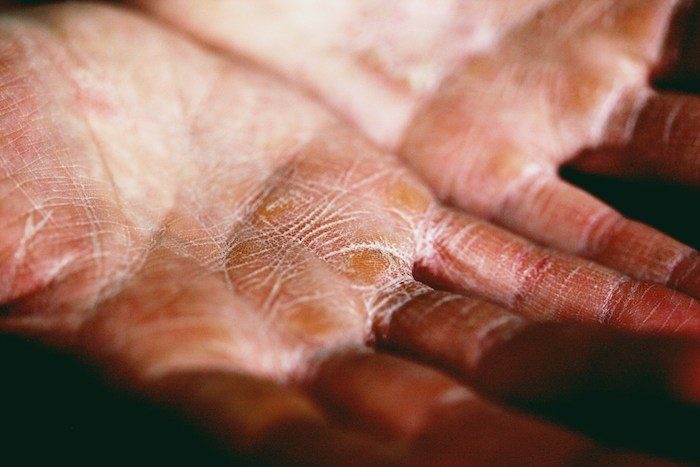
Have you ever felt the discomfort of dry patches on skin?
If so, you’re not alone. Many of us have experienced the frustration of dealing with these pesky patches that seem to appear out of nowhere, disrupting our otherwise smooth appearance.
Whether it’s a small spot on your cheek or a larger area on your arms or legs, dry patches can be a source of annoyance and self-consciousness. Understanding the causes and learning how to prevent and treat them can help you reclaim your skin’s natural radiance.
Common Causes Dry Patches on Skin
Dry patches of skin can be caused by a variety of factors, both internal and external.
Lack of Moisture
One of the primary culprits is a lack of moisture. When your skin becomes dehydrated, it loses its ability to retain moisture, leading to dryness and flakiness. This can be exacerbated by environmental factors such as cold weather, low humidity, and excessive exposure to sun or wind.
Aging can also make your skin dry out faster than it used to. As we age, our skin doesn’t produce as much sebum (natural skin oil) as it did when we were younger. This decrease in oil leads to dryness and a rough texture. The skin thins with age, too, as the production of collagen and elastin drops. This makes it more susceptible to dryness and dehydration.
Compromised Barrier Function
Another common cause of dry patches is a disruption in the skin’s natural barrier function. This can occur due to harsh skincare products, excessive exfoliation, or certain medical conditions such as eczema or psoriasis. When the skin’s barrier is compromised, it becomes more susceptible to moisture loss and irritation, resulting in dry, rough patches.
Aging can compromise the skin’s barrier function too. The skin’s barrier consists of a layer of lipids (fats) that help to seal in moisture and prevent water loss. As we age, this lipid barrier can become less effective, leading to increased transepidermal water loss (TEWL) and dryness. Factors such as sun damage, environmental pollutants, and harsh skincare products can further weaken the skin’s barrier, exacerbating dry skin issues.
Lifestyle Factors
Lifestyle factors such as poor diet, stress, and lack of sleep can also contribute to dry patches by impacting the overall health of your skin. Consuming a diet low in essential nutrients and antioxidants can deprive your skin of the nourishment it needs to stay hydrated and supple, while stress and lack of sleep can disrupt your body’s natural balance and impair its ability to repair and regenerate skin cells.
Skin Conditions
Skin conditions such as psoriasis, eczema, and contact dermatitis can all contribute to the development of dry patches on the skin due to their underlying inflammatory nature and disruption of the skin’s barrier function.
Psoriasis
Psoriasis is a chronic autoimmune disorder characterized by the rapid turnover of skin cells, leading to the formation of thick, red, scaly patches known as plaques. The excessive shedding of skin cells in psoriasis can disrupt the skin’s barrier function, allowing moisture to escape and leading to dryness and flakiness. Additionally, inflammation associated with psoriasis can further impair the skin’s ability to retain moisture, exacerbating dry skin symptoms.
Eczema
Eczema, also known as atopic dermatitis, is a chronic inflammatory skin condition characterized by dry, itchy, and inflamed skin. Defects in the skin barrier allow irritants and allergens to penetrate the skin, triggering an immune response and inflammation. This inflammation disrupts the skin’s natural moisture balance, leading to dry patches that can become red, rough, and cracked. Persistent scratching can further damage the skin barrier, exacerbating dryness and increasing the risk of infection.
Contact Dermatitis
Contact dermatitis is a type of skin inflammation that occurs when the skin comes into contact with an irritant or allergen. The inflammatory response can disrupt the skin’s barrier function, leading to dryness, redness, and the development of dry patches. Continued exposure to the offending irritant or allergen can prolong inflammation and delay the skin’s healing process, perpetuating dry skin symptoms.
How to Prevent Dry Patches of Skin
No matter what kind of skin you have, there are several steps you can take to prevent dry patches from forming in the first place.
1. Hydrate from the Inside Out
Drink plenty of water throughout the day to keep your body and skin hydrated. Consider incorporating hydrating foods into your diet, such as water-rich fruits and vegetables.
2. Choose Gentle Skincare Products
Opt for mild, fragrance-free cleansers and moisturizers that won’t strip your skin of its natural oils or cause irritation. Look for products containing ingredients like hyaluronic acid, glycerin, and ceramides, which help to attract and retain moisture.
Our CV Skinlabs products are made specifically to address skin barrier concerns and help skin hold onto moisture. All are perfect for sensitive skin, and when used regularly, can help reduce inflammation and restore hydration and radiance.
3. Protect Your Skin from the Elements
Wear sunscreen daily to shield your skin from the harmful effects of UV radiation, and use a humidifier to add moisture to the air in dry indoor environments. When venturing outdoors in cold or windy weather, cover exposed skin with protective clothing to prevent moisture loss.
4. Practice Gentle Exfoliation
While exfoliating can help remove dead skin cells and promote cell turnover, overdoing it can damage the skin’s barrier and exacerbate dryness. Limit exfoliation to once or twice a week, and choose gentle exfoliants that won’t cause irritation or inflammation. Avoid harsh crystal and nut scrubs, and choose gentle exfoliating acids like malic, glycolic, salicylic, and lactic.
5. Adopt a Healthy Lifestyle
Manage stress through relaxation techniques such as meditation or yoga, prioritize sleep for optimal skin regeneration, and maintain a balanced diet rich in vitamins, minerals, and antioxidants to support overall skin health.
How to Treat Dry Patches on Skin
If you’re already dealing with dry patches, don’t despair. There are several steps you can take to help alleviate symptoms and restore moisture to your skin.
1. Moisturize Regularly
This is one of the most important steps you can take immediately. Apply a rich, emollient moisturizer to affected areas immediately after showering or bathing to lock in moisture and prevent further dryness. Then apply throughout the day whenever needed.
Look for products specifically formulated for dry or sensitive skin, and consider using a thicker cream or ointment for added hydration. We recommend our Restorative Skin Balm as it’s specifically made to soften severely dry and chapped skin. Perfect for eczema, dermatitis, and other types of dry patches, it helps reduce inflammation and heal skin while creating a soothing barrier to trap moisture.
Apply the balm to dry patches at least twice a day, then use our regular Calming Moisture and Body Repair Lotion on the face and body skin morning and night.
2. Avoid Harsh Ingredients
Steer clear of skincare products containing alcohol, fragrances, or other potentially irritating ingredients that can further dry out your skin or cause inflammation. Instead, opt for gentle, hypoallergenic formulations that won’t exacerbate existing dry patches. All of our CV Skinlabs products are perfect for treating dry patches.
3. Try Soothing Remedies
In addition to frequent moisturizing, try natural remedies such as oatmeal baths and Epsom salts to help soothe dry, irritated skin and promote healing. We also recommend our Rescue + Relief Spray for an instant, cooling treatment. Take our travel size with you and spritz on areas that feel dry and tight at any time.
4. Protect the Skin
For dry patches to heal, you need to baby them. Cover them up when you go out into the sun, wind, or cold weather, then consider covering them overnight, too. Apply our Restorative Skin Balm to the hands and/or feet, then wear soft cotton gloves or socks to bed. If your dry patches are on your arms or legs, consider wearing long-sleeved and pant-style pajamas to bed until your skin starts to heal.
If the dry patches are on your hands and you frequently wash them, apply moisture after every wash, no exceptions!
5. Seek Professional Help
If dry patches persist despite your best efforts, consider consulting a dermatologist for personalized treatment recommendations. A dry patch of skin can sometimes be a sign of skin cancer or a precancerous condition. Doctors can help identify any underlying medical conditions contributing to your symptoms and prescribe appropriate medications or therapies to address them effectively.
Do you struggle with dry patches on your skin?
Featured image by Alexander Grey via Unsplash.






